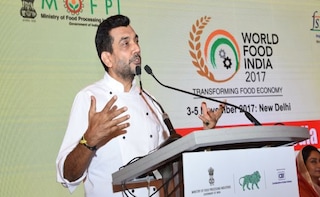Chef Sanjeev Kapoor needs no introduction. He’s been blessed with talent, determination and luck and has certainly got the magic touch when it comes to cooking. His brilliant recipes and his infectious smile have made their way into our hearts and we were delighted to catch up with him during World Food India 2017 – the three-day long food fair that aimed at promoting the Food Processing Sector in India. One of the highlights of the festival was a lovely Food Street curated by him where you could enjoy the best of regional Indian food – everything from a royal Hyderabadi Mutton Biryani and Coastal Daab Chingri to Punjabi Sarson Da Saag and fragrant Assamese Fish Curries. We had an interesting conversation with him at the event about the future of Indian food and the role of technology and digital media in the culinary world.
1. Can you predict the future of Indian food? Any emerging trends that you’ve noticed in Indian cuisine?
In this new digital age, it has definitely become easier to connect with and reach out to your target audience. Food is being consumed in many different ways and lots of conversations around food are emerging thanks to social media which gives easy access to information. This digitization is making food more accessible and endearing and is getting the younger generation more involved with food. The simplest tip to all the cooks and chefs out there that I would like to give is to innovate. It could be on the medium you choose to use, on the recipe, on presentation or on the lighting –innovation is the key.(Also read: 918 Kgs Of Khichdi, It's A Guinness World Record!)
1. Can you predict the future of Indian food? Any emerging trends that you’ve noticed in Indian cuisine?
Advertisement
Advertisement
In this new digital age, it has definitely become easier to connect with and reach out to your target audience. Food is being consumed in many different ways and lots of conversations around food are emerging thanks to social media which gives easy access to information. This digitization is making food more accessible and endearing and is getting the younger generation more involved with food. The simplest tip to all the cooks and chefs out there that I would like to give is to innovate. It could be on the medium you choose to use, on the recipe, on presentation or on the lighting –innovation is the key.
Advertisement
For the latest food news, health tips and recipes, like us on Facebook or follow us on Twitter and YouTube.
Advertisement
